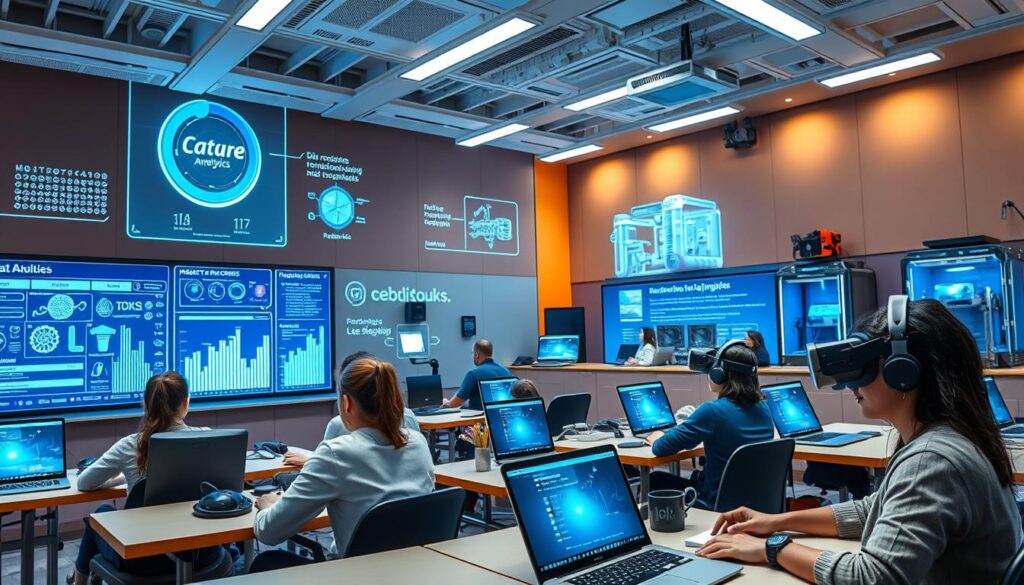The Diploma in Information Technology is a key program. It teaches students the IT skills needed in today’s tech world. Students learn both practical and theoretical aspects, readying them for many IT roles. This includes programming, database management, network administration, and cybersecurity.

Getting a Diploma in Information Technology opens doors to a fulfilling tech career. It gives you the skills to succeed in the tech field. With a solid IT foundation, you can take on various roles, helping drive innovation and growth.
Key Takeaways
- Develop a strong foundation in IT skills, including programming, database management, and network administration.
- Prepare for a wide range of roles in the IT sector, from Automation Engineer to Game Programmer.
- Gain practical experience through team projects and industry orientation programs.
- Acquire specialized knowledge in areas like Artificial Intelligence, Cloud Computing, and Software Engineering.
- Enhance career prospects with industry-relevant certifications and a strong professional portfolio.
- Pursue a lucrative tech career, with opportunities for growth and advancement in the industry.
Understanding the Diploma in Information Technology
The field of information technology is growing fast. An Information Technology Diploma is a great way to start a career in IT. This information technology program teaches you about business software, networking, and more. It’s flexible, lasting 12–18 months, and offered online or on-campus.
Computer science and IT programs cover programming, networking, and database management. To join, you need a high school diploma or similar. Some programs ask for math or computer science classes first.

- Program duration and format: 12–18 months, available on-campus and online
- Entry requirements: high school diploma or equivalent, with possible prerequisite courses in mathematics or computer science
- Coursework: hands-on courses covering business software, networking technology, troubleshooting, and design
Knowing what the Information Technology Diploma offers helps you choose the right path. It’s key for a career in information technology.
Core Components of IT Diploma Programs
IT diploma programs give students a strong base in information technology. Programming languages are key to this foundation. Students learn languages like Python, Java, and C++.
Another important part is database management. Students learn to design and manage databases with tools like MySQL and Oracle.
IT diploma programs include many courses. These cover various IT aspects. Some main courses are:
- Introduction to Computers
- Web, Programming, and Database Foundation
- Network and Security Foundation
- Information Systems Business Concepts
These courses help students understand IT well. They prepare students for IT careers.

Learning programming languages and database management is vital. It builds a strong base for an IT career. With these skills, IT professionals can work in many areas, like software development or network administration.
| Course | Credits | Class Hours | Lab Hours |
|---|---|---|---|
| Introduction to Computers | 3 | 2.00 | 2.00 |
| Web, Programming, and Database Foundation | 3 | 2.00 | 2.00 |
| Network and Security Foundation | 3 | 2.00 | 2.00 |
Essential Technical Skills You’ll Develop
In the Information Technology Diploma program, you’ll learn many important technical skills. These skills are key for a career in tech. You’ll learn about programming languages, database management, and network administration.
Programming Languages and Database Management
Programming languages like Java, Python, and C++ are vital for software development. Database management skills are also essential for storing and retrieving data. You’ll learn both theory and practice, preparing you for real-world challenges.
Network Administration and Cloud Computing
You’ll also learn about network administration and cloud computing. These skills are important for designing and maintaining networks. They also help manage cloud-based services and infrastructure. With more companies using cloud computing, you’ll be ready for a successful career.

| Skill Area | Description |
|---|---|
| Programming Languages | Development of skills in languages such as Java, Python, and C++ |
| Database Management | Development of skills in data storage and retrieval |
| Network Administration | Development of skills in network design and maintenance |
| Cloud Computing | Development of skills in cloud-based services and infrastructure management |
Specialization Tracks in IT Diplomas
IT diploma programs let students focus on areas they love in the big world of information technology. They can dive into cybersecurity or artificial intelligence. These special tracks can make students stand out in the job market.
Some top specializations in IT diplomas are:
- Cybersecurity
- Artificial intelligence
- Network administration
- Cloud computing
These specializations open doors to many careers. You could work in cybersecurity or artificial intelligence. With more jobs in IT, picking a special track is smart.

The Bureau of Labor Statistics says jobs for info security analysts will jump by 32% by 2032. That’s a big boost for cybersecurity careers. Also, artificial intelligence is growing fast, with lots of uses in different fields.
Industry-Relevant Certifications
IT professionals with industry-relevant certifications have better job prospects and career growth. Certifications like those from CompTIA show expertise and knowledge in IT areas. They are widely recognized in the field.
Graduates of the Information Technology Assistant Diploma program are ready for industry-standard certificates. The CompTIA A+ certification exam is a key step in starting an IT career. It’s a valuable addition to an IT diploma.
CompTIA Certifications
CompTIA certifies over 75 million professionals worldwide. They offer various certifications that prove basic security, networking, and data skills. Popular ones include CompTIA Security+, Network+, and Data+.

Cisco Certifications
Cisco certifications, like the Cisco Certified Network Associate (CCNA), are also highly valued. They show networking expertise and are great for IT diplomas.
IT pros with new certifications see an average salary boost of $13,000. This shows how important certifications are in the job market. With more demand for IT security, CompTIA Security+ is key for showing security skills.
Practical Experience and Project Work
Practical experience and project work are key parts of IT diploma programs. They let students use what they’ve learned in real situations. Through project management and IT projects, they learn teamwork, problem-solving, and how to communicate well.
Students get to work on software development, from start to finish. They also design and build web applications using databases. The program teaches data skills, like making data dashboards and analyzing data.
Here are some important skills students will learn through practical work:
- Agile project development methodologies
- Information Systems architecture
- Front-end web development using HTML and CSS
- Secure coding principles

By working on IT projects, students get to know the industry well. They learn the skills and knowledge needed for their future careers. The focus on project management also helps them improve in leadership, communication, and solving problems.
| Skill | Description |
|---|---|
| Project Management | Developing essential skills in leadership, communication, and problem-solving |
| IT Projects | Gaining hands-on experience in software development, database design, and web application development |
Career Opportunities After Graduation
After finishing an IT diploma, you can find many tech jobs. You might work as a help desk technician, computer support specialist, or junior network administrator. With more experience and extra education or certifications, you can move up to senior positions. You could also focus on areas like cybersecurity or artificial intelligence.
The IT career offers many paths and good pay. Reports show that jobs in IT will grow a lot in the next few years. This means there will be more chances for skilled workers. Some jobs you might find include:
- Computer Network Support Specialist
- Certified Computer Technician
- Systems Analyst
- Application Developer
- Web Designer
More and more industries need IT experts. So, there are more IT career options and tech jobs to pick from.

| Career Path | Job Description | Salary Range |
|---|---|---|
| Computer Network Support Specialist | Install, configure, and troubleshoot computer networks | $50,000 – $80,000 |
| Certified Computer Technician | Repair and maintain computer systems and hardware | $40,000 – $70,000 |
| Systems Analyst | Analyze and design computer systems to meet business needs | $60,000 – $100,000 |
Modern Technologies Covered in the Curriculum
The IT curriculum keeps up with the tech industry’s fast changes. It includes modern technologies and trends. This means learning about blockchain, the Internet of Things (IoT), and big data analytics. It also covers the basics of computer science and information technology.
Some important topics in the IT curriculum are:
- Security: including cybersecurity, network security, and cloud security
- Hardware: including computer architecture, networking, and database systems
- Software applications: including programming languages, software engineering, and data analytics
- Artificial intelligence: including machine learning, natural language processing, and computer vision

By adding modern technologies to the IT curriculum, students get ready for the industry. They learn the basics of IT curriculum and can choose many careers. These include cybersecurity, data analytics, software development, and artificial intelligence.
By adding modern technologies to the IT curriculum, schools give students the skills to thrive in the tech world.
Building Your Professional Portfolio
As an IT diploma graduate, it’s key to have a professional portfolio. It shows off your skills, projects, and experiences to employers. A good portfolio proves you can handle real-world projects and highlights your strengths.
To make a strong portfolio, document your projects well. Manage your GitHub repository and have a professional online presence. This will help you stand out to employers.
Your portfolio should have projects that show your technical skills. This includes programming languages, database management, and network administration. Cloud computing projects are also important, as they’re in high demand.
By mixing personal and professional projects, you show your versatility. This makes you a more attractive candidate to employers.
Project Documentation
When documenting your projects, include the project’s goal, your role, and the technologies used. This helps employers understand your skills and experience. You can also add screenshots or links to live projects for a better experience.
GitHub Repository Management
GitHub is vital for developers. A well-managed repository shows your coding skills. Keep your repository updated with clear commit messages and organized folders and branches.
This shows you can work on team projects and manage version control. It’s important for your portfolio.
Online Presence Development
In today’s digital world, having a professional online presence is essential. Create a personal website or LinkedIn profile to showcase your skills and projects. This makes it easy for employers to find and contact you.
Include a clear summary of your skills and experience. Don’t forget to mention any relevant certifications or education.
By following these tips, you can build a strong portfolio. Keep it updated and tailored to your job market. With a solid portfolio and online presence, you’ll be ready for your dream IT job.

| Project | Technologies Used | Role |
|---|---|---|
| Cloud Computing Project | AWS, Python, Java | Lead Developer |
| Database Management Project | MySQL, MongoDB | Database Administrator |
| Network Administration Project | Cisco, Juniper | Network Engineer |
Industry Partnerships and Networking Opportunities
Industry partnerships and networking are key in IT diploma programs. They let students meet professionals and learn about new tech and practices. These connections can open doors to internships, jobs, and mentorship, all helping your career.
For example, UW-Stout’s Business Information Technology program focuses on industry partnerships. Heartland Business Systems, named Employer of the Year, shows how important these partnerships are in IT.
Some main benefits of industry partnerships and networking are:
- Access to job placements and internship opportunities
- Insights into the latest technologies and practices
- Mentorship and career guidance
- Opportunities for skill development and certification

By using industry partnerships and networking chances, IT diploma students can boost their career chances. They can stay competitive in the job market.
| Program | Industry Partnerships | Networking Opportunities |
|---|---|---|
| UW-Stout’s Business Information Technology | Heartland Business Systems | Internship opportunities, job placements, and mentorship |
| Bryant & Stratton College’s AAS Networking Technology | Simulation labs and industry certification exams | Job placements and career advancement opportunities |
Financial Investment and ROI
Thinking about the cost and return on investment (ROI) is key when looking at IT diploma programs. Tuition can be a big expense, but financial aid options are available. These include federal student aid, scholarships, and help from employers.
The ROI for an IT diploma can be huge. With the need for skilled IT workers, graduates can earn more and move up in their careers. Studies show that a bachelor’s degree can bring a 681.95% return over a lifetime, with a median of 1,041.85%.
Here’s a look at the costs and benefits:
| Category | Estimated Cost/Benefit |
|---|---|
| Initial Investment | $255,217 |
| Average Cost of Tuition | $143,268 |
| Estimated Lifetime Total Earnings | $7.271 million |
| Median Earnings for Bachelor’s Degree Holders | $74,150 |

Though the upfront cost is high, the long-term gains make an IT diploma a good choice. It’s a solid path for those aiming for a career in IT.
Student Support Services
Student support services are key in any academic program, including the Diploma in Information Technology. They offer students the tools they need to do well in school and in their careers. Academic services like tutoring, career advice, and access to technology are all important.
Some main features of these services include
- e-books and other digital resources
- 24/7 tutoring and academic support
- career services to help students achieve their professional goals
- access to parking and other facilities
These services aim to improve the student experience. They create a supportive community for learning and growth.
By providing student support services, schools help students overcome challenges. They offer one-on-one tutoring, career advice, and access to new technology. These services are vital for student success.

In today’s fast-paced academic world, academic services are more vital than ever. Investing in student support shows a school’s dedication to student success. It creates a positive and supportive learning environment.
Conclusion
The digital world is changing fast, and we need more IT experts than ever. The Diploma in Information Technology gives students the skills and knowledge they need to succeed. It prepares them for a tech career full of chances to grow and move up.
IT diploma holders can start in many roles, from basic IT support to top jobs in areas like cybersecurity and cloud computing. The program’s focus on real-world skills helps students stand out in the job market. They’re ready to help big companies in many fields.
If you’re new to tech or want to change your career, the Diploma in Information Technology is a great choice. It’s a strong base for a fulfilling IT career. Start your journey now and see how your tech skills can change the world.
FAQ
What is a Diploma in Information Technology?
The Diploma in Information Technology is a starting point for a career in tech. It teaches students the skills needed to keep up with IT changes.
What are the core components of an IT diploma program?
IT diploma programs focus on key areas. These include programming languages like Python, Java, and C++. They also cover database management systems and network administration.
What technical skills will I develop in an IT diploma program?
You’ll learn programming, database management, network administration, and cloud computing. These skills are vital for the tech world.
What specialization tracks are available in IT diploma programs?
You can choose from specializations like cybersecurity. This focuses on protecting systems and networks. Another option is artificial intelligence, which deals with creating intelligent machines.
What industry-relevant certifications can I earn through an IT diploma program?
You can get certifications from CompTIA, Cisco, and Microsoft. These are highly valued in the industry. They can boost your job prospects and career growth.
What are the career opportunities available after completing an IT diploma program?
After graduating, you can start as a help desk technician or computer support specialist. You can also become a junior network administrator. There’s room for growth and specialization in areas like cybersecurity or artificial intelligence.
What modern technologies are covered in the IT diploma curriculum?
The curriculum includes new technologies like blockchain and the Internet of Things (IoT). It also covers big data analytics, along with computer science and IT basics.
How can I build a professional portfolio as an IT diploma graduate?
To build a portfolio, document your projects and manage GitHub repositories. Show off your coding skills. Also, create an online presence on LinkedIn or a personal website.
What are the financial considerations for an IT diploma program?
It’s important to know the tuition costs and financial aid options. Also, consider the long-term career benefits. This helps you make a smart financial choice for your IT diploma.
What student support services are available in IT diploma programs?
Support services include academic advising, tutoring, and career counseling. You also get access to technology and software. These services help create a supportive learning environment.